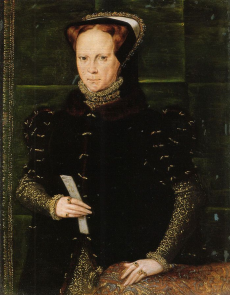
Queen Mary the First of England, known to many as Bloody Mary, is recognised as one of the most brutal monarchs ever to sit on the English throne. Her relentless live executions of protestants, who were burnt to death, is all that she is remembered for, her famous and formidable portrait seemingly depicting a murderous Queen, determined to destroy the Protestant England her father and brother worked to build. Of course, it is never mentioned that whilst she was responsible for the executions of 283 people on the basis of heresy, her father ordered 7,200. Mary, who we all conveniently forget was the first Queen of England, has, in my belief, been portrayed in a heinously unjust fashion. Whilst she was, by no means, a great monarch, she is undeniably not the most ruthless, cunning, or pugnacious royal to ever sit on the English throne, and, in retrospect, her reign, deserves our pity, rather than our distaste. I hope, for the sake of Her Majesty’s memory, that I am able to convince at least some of you to see her in a kinder light.
Princess Mary Tudor was born in February 1516, and from an early age, showed signs of the great Tudor intelligence, shared by both her father, and grandfather. At age nine, she could read and write Latin, whilst simultaneously studying French, Spanish, Music, Dance and Greek. Adored by the King, Mary was the darling of the Royal Court. That is, until the early 1530s, when Henry decided that he’d rather have a son than the woman he was married to for 24 years, and divorced Mary’s mother, as well as changing the entire religion of the country. Suddenly, the 17-year-old Mary was not permitted to see her mother, and suffered from a serious bout of depression. Constantly ill, and banned from court for refusing to recognise Elizabeth as Princess, Anne as Queen, or convert to Protestantism, she was eventually permitted to return after being bullied into signing a document which named Henry as head of the church. Things only got worse from there.
After the son of the Countess of Salisbury, Mary’s governess, was implicated to have organised a Catholic plot, the Countess was executed. Mary watched as the woman who raised her was ‘hacked to pieces’ by ‘a wretched and blundering youth’. Attending a Christmas reunion for herself, Elizabeth, and her brother, the then King, Edward, embarrassed her in front of the entire court, reproving her for refusing to change her faith, and leaving her in tears. Of course, when she reached power, things would improve, right?
Wrong.
When deciding to marry Phillip of Spain, and thereby allying England with a powerful country, Mary was exceedingly careful. After spending time with parliament, an act was produced announcing that Phillip was King of England in name, only. He could not act without his wife’s consent, and when Mary died, he would lose all power. Whilst it appears that Mary was enamoured with him, it seems that he held no affection for her whatsoever, spending as much time abroad as possible. Things appeared to improve when Mary was seemingly pregnant – her stomach swelled, and she suffered from morning sickness. However, this was later discovered to be a false pregnancy. This phenomenon occurs when a woman wants to have a child so badly, that her body mimics the symptoms of pregnancy, although no child has, in fact, been conceived. A few years later, it appeared that Mary was pregnant once more. Unfortunately no child was born – the swelling of the stomach she experience was uterine cancer, the cause of her death a few months later.
The unfortunate life of a woman who was attempting to hold onto the faith she had been raised. Remembered only for her execution of 283 people, without the inclusion of her policies of fiscal reform, naval expansion and colonial exploration, which flourished under Elizabeth’s reign to be recognised as one of the great Tudor accomplishments. Because she was Catholic, Mary was quickly condemned by the Protestants in positions of power following her reign, allowing a bloody image to be painted of her, which would never be wiped clean. Hopefully, this condensed account of Mary’s life will demonstrate why I believe she has been unjustly depicted, and maybe even inspire pity for the first Queen of England.
Image: http://listverse.com/2007/09/09/top-10-most-evil-women/

0 Comment:
Be the first one to comment on this article.